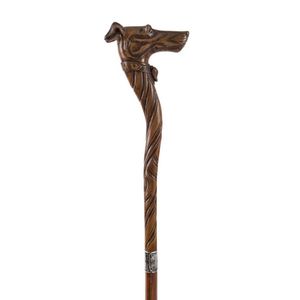Victorian Dog Head Walking Stick with Articulated Mouth
You must be a subscriber, and be logged in to view price and dealer details.
Subscribe Now to view actual auction price for this item
When you subscribe, you have the option of setting the currency in which to display prices to $Au, $US, $NZ or Stg.
- Boxwood - Boxwood is a hard, yellow coloured, close grained timber. In the 19th century it was often used for inlays, especially stringing, because of its contrasting colour to the darker timbers of the carcase. Stringing is the inlay of a narrow strip of veneer of a lighter colour, such as boxwood along or close to the edges of an object that has been veneered in a darker timber such as mahogany.
Because of its fine grain and resistnce to splitting or chipping it has also been used for treen, turnings, carvings and other small wooden items, such as chess pieces. - Victorian Period - The Victorian period of furniture and decorative arts design covers the reign of Queen Victoria from 1837 to 1901. There was not one dominant style of furniture in the Victorian period. Designers used and modified many historical styles such as Gothic, Tudor, Elizabethan, English Rococo, Neoclassical and others, although use of some styles, such as English Rococo and Gothic tended to dominate the furniture manufacture of the period.
The Victorian period was preceded by the Regency and William IV periods, and followed by the Edwardian period, named for Edward VII (1841 ? 1910) who was King of the United Kingdom and the British Dominions and Emperor of India for the brief period from 1901 until his death in 1910.
This item has been included into following indexes:
Visually similar items

A finely carved 19th century Maori tewhatewha. Carved with spirals, fern shapes, criss cross etc. Two paua shell inlays (80% carved) by a master carver. (good quality, Taranaki style). Provenance: Purchased at Dunbar Sloane Auckland, 2005. Length 120 cm

A carved door, green river area, upper Sepik river, Papua New Guinea

A spelter figure of a shot-put thrower, circa 1900, in deep bronze tones, the well patinated figure of a young man in baggy shorts and a singlet positioned to deliver a shot, incised signature of Ruffony to the rough base, with relief cartouche 'France' to

An Art Nouveau bronze figure of a naked maiden, standing arched backward holding a floral garland, indistinctly signed, on a slate base, 40 cm high
